Sharing and Measuring Class 4 Maths Mela Chapter 5 Questions Answers
Explore Questions and Answers related to the Class 4 Maths Mela Chapter 5 Sharing and Measuring with illustrations and diagrams.
Sharing and Measuring Class 4 Maths Mela Chapter 5 Questions Answers – PDF Download
Page 62
Let Us Discuss
1. Which part of the paper you would have chosen—one half or two quarters? Why?
Solution:
I would have chosen either option, as both one-half and two quarters represent the same portion of the paper.
2. Do you think Ikra shared the paper equally? Why? Try with a paper.
Solution:
Yes, Ikra shared the paper equally because two quarters of the paper are the same as one half. When you try it with a paper, you’ll see that two quarters cover the same area as one half.
3. How do you know that the paper has been divided equally?
Solution:
I know the paper has been divided equally because two quarters of the paper cover the same area as one half.
4. Why do you think Samina chose two quarters of the paper?
Solution:
Samina chose two quarters of the paper because she thought that by selecting two pieces, she was getting a larger portion of the paper.
Page 63
Let Us Do
1. Samina has divided some figures into two parts. Colour the figures that are divided into halves correctly. How did you get the answer?

Solution:

Figures 1, 3, and 4 are divided into two halves correctly because both halves are equal in size.
2. Divide the shapes into halves by drawing a line.
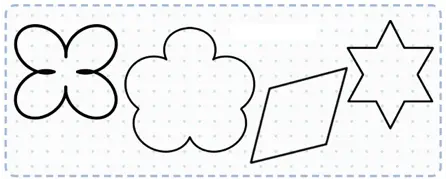
Solution:
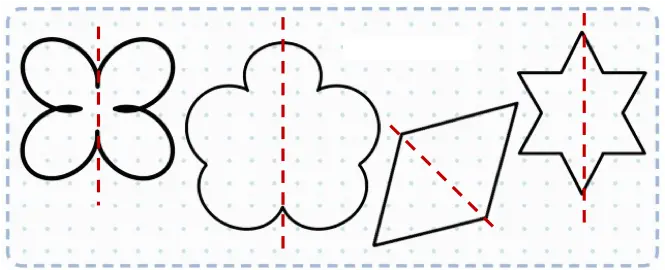
Page 64
3. Divide these shapes into 4 equal parts/quarters.

Solution:
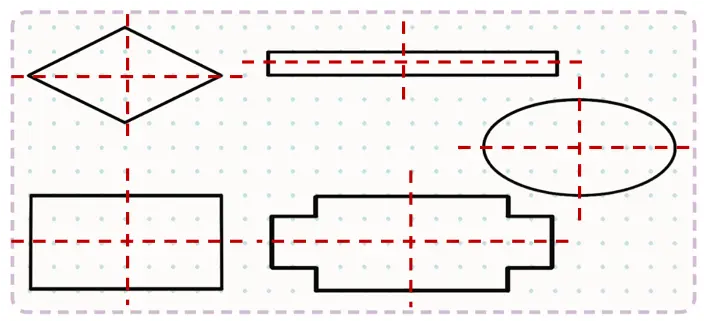
Think: How would we write the fraction for each part if we divided an object into 5 equal parts?
Solution:
The fraction for each part if we divide an object into 5 equal parts is 1/5.
Let Us Try
1. In how many different ways can you fold/cut a rectangular paper in two equal parts? Try it with a rectangular paper.

Solution:
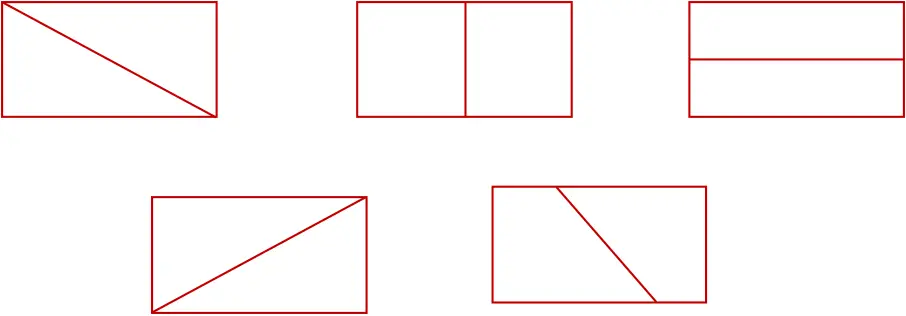
Therefore, there are five different ways in which a rectangle can be folded into two equal parts.
Page 65
2. Now try to draw and show five different ways in which we can fold/ cut a rectangle into four equal parts (1/4 or quarter).

Solution:
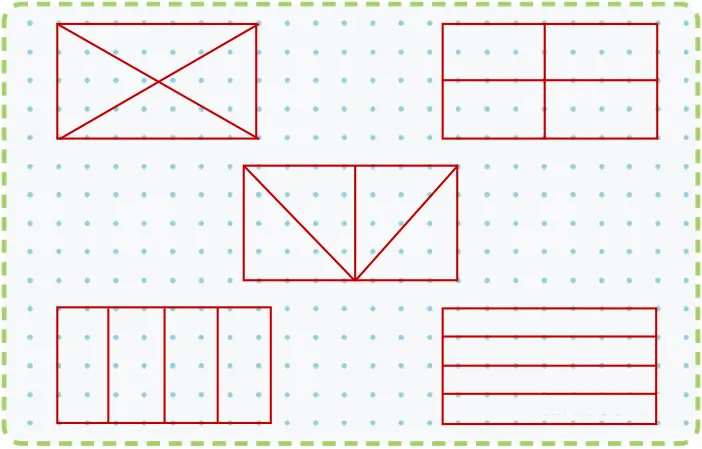
3. Match the following parts with their corresponding wholes.
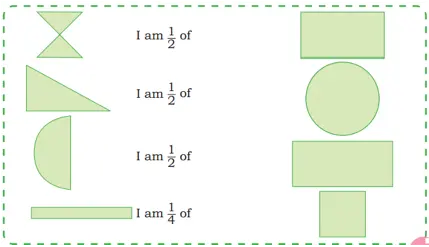
Solution:
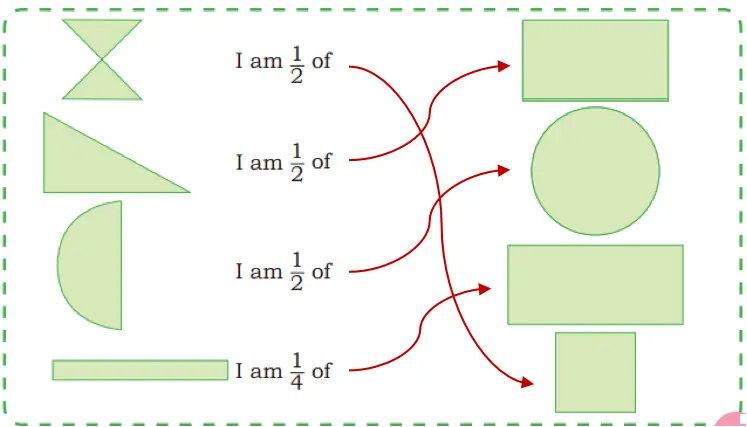
Page 68
Q. How much dhokla does Sumedha get now?
Solution:
Part of dhokla each children got = 1/5.
Sumedha’s share = 1/5 + 1/5 = 2/5.
Let Us Discuss
1. What is Sumedha observing about her share as each guest comes in?
Solution:
Sumedha is observing that as each guest comes in, her share of dhokla keeps getting smaller.
2. In which situation will Sumedha get to eat more dhokla: when shared among 9 people or 11 people?
Solution:
The fewer the number of people among whom the dhokla is shared, the greater the share of each person. Thus, Sumedha will get to eat more dhokla when it is shared among 9 people.
3. How many pieces of 1/6 would make a complete dhokla?
Solution:
Since, 6 × 1/6 = 1
Therefore, 6 pieces of 1/6 would make a complete dhokla.
4. What would be Sumedha’s share, If Idha and Vinayak both give their share of dhokla to her?
Solution:
After receiving Idha’s and Vinayak’s shares, Sumedha’s share becomes: 1/5 + 1/5 + 1/5 = 3/5.
Let Us Do
1. How much dhokla would each person get if it was shared equally among 6 people? Try also with 8 people. Who will get the bigger pieces of dhokla? Draw and explain.
Solution:
Share of each person if dhokla is shared among 6 people = 1/6.
Share of each person if dhokla is shared among 8 people = 1/8.
Since the fewer the number of people among whom the dhokla is shared, the larger each person’s share. Therefore, the group of 6 people will get the bigger pieces of dhokla.
Page 69
2. Shade a portion of the dhokla to represent the fraction Sumedha would get when the dhokla is shared equally among the given number of people. Discuss why the fractions get smaller.
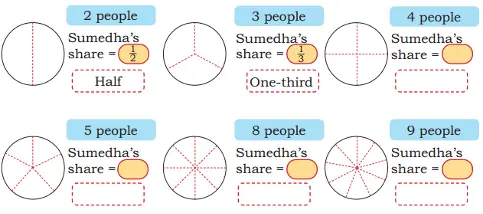
Solution:
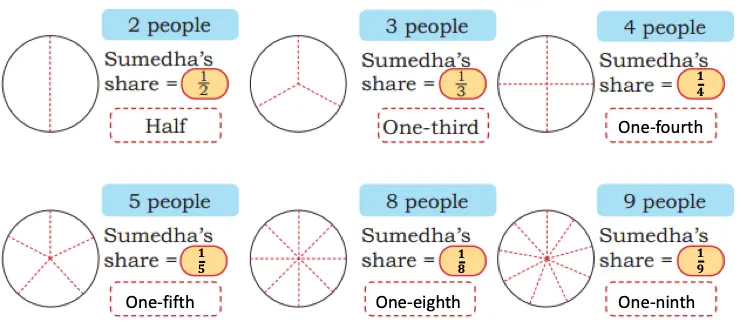
Let Us Discuss
Use the fraction kit given at the end of your textbook and answer the following questions.
1. Share your observations about the different pieces and the whole.
Solution:
As the whole is divided into a larger number of pieces, the size of each piece gets smaller.
2. Take any two different pieces of the fraction kit and compare them. Discuss which one is smaller and why.
Solution:

1/3 is smaller than 1/2 because the greater the number of equal pieces a whole is divided into, the smaller each piece becomes.
3. Sumedha noticed that when a whole is equally divided in a larger number of parts, each part gets smaller. Do you agree with Sumedha?
Solution:
Yes, I do agree with Sumedha.
4. Sumedha says, “When I join 5 pieces of 1/5, it makes a whole dhokla.” Try to do it yourself with your fraction kit.
Solution:
5 × 1/5 = 1.
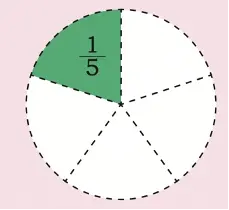
5. Sumedha says that this part is one-third of the complete whole. Why is she saying so?
Solution:
Sumedha is saying so because the whole is divided into 3 equal parts.
3 × 1/3 = 1.
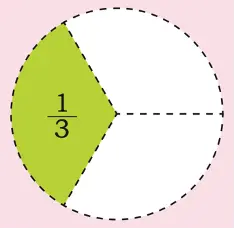
Page 70
Q. Let us try to fill in the blanks. Both the fractions are parts of the same whole. Use your fraction kit, if necessary. Share your thoughts.
1. ________ is greater than ________ (1/5, 1/4).
2. ________ > ________ (1/9, 1/6).
3. 1/6 ________ 1/8.
4. ________ is smaller than ________ ( ____ , ____ ).
Solution:
1. 1/4 is greater than 1/5.
2. 1/6 > 1/9.
3. 1/6 > 1/8.
4. 1/3 is smaller than 1/2.
Q. Look at the garden and answer the following questions:

Mogra in 1/5 or one-fifth part of the garden.
Marigold in _______ part of the garden.
Jasmine in _______ part of the garden.
Rose in 1/5 and 1/5 or a total of 2/5 (two-fifths) part of the garden.
Solution:
Marigold in 1/5 part of the garden.
Jasmine in 1/5 part of the garden.
Page 71
Q. Look at the garden and answer the questions.

Mogra in _______ part.
Marigold in _______ part.
Rose in 1/5 + 1/5 + 1/5 part or a total of 3/5 (three-fifths) part.
Solution:
Mogra in 1/5 part.
Marigold in 1/5 part.
Q. Look at the garden and answer the questions.

Marigold in _______ part.
Rose in 1/5 + 1/5 + 1/5 + 1/5 or a total of 4/5 (four-fifths) part.
Solution:
Marigold in 1/5 part.
Let Us Do
Make a flower garden with seven flowering seeds—Mogra, Marigold, Jasmine, Rose, Lily, Hibiscus, and Periwinkle?
a) Marigold in one-seventh (1/7) and Rose and Hibiscus in three-sevenths (3/7) part each.
Solution:

b) Lily in three-sevenths (3/7), Marigold in two-sevenths (2/7) and Periwinkle in another two-sevenths (2/7).
Solution:

Page 72
c) Mogra in five-sevenths (5/7) part and Hibiscus in two-sevenths (2/7).
Solution:

Page 73
Do It Yourself
Q. Write the fractions for each of the toppings in the following dosas.
(i)
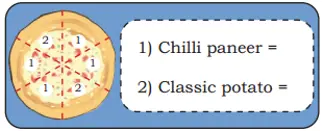
Solution:
Total pieces = 6
1) Chilli panner = 4/6
2) Classic potato = 2/6
(ii)
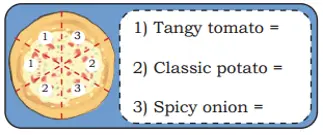
Solution:
Total pieces = 6
1) Tangy tomato = 2/6
2) Classic potato = 2/6
3) Spicy onion = 2/6
(iii)
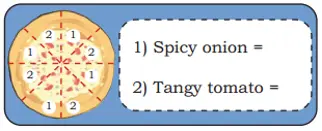
Solution:
Total pieces = 8
1) Spicy onion = 4/8
2) Tangy tomato = 4/8
(iv)

Solution:
Total pieces = 6
1) Tangy tomato = 1/6
2) Classic potato = 2/6
3) Spicy onion = 3/6
Q. Now you can make different dosas based on demand.
(i) Make a dosa with 2/3 topping of Spicy onion, 1/3 of Classic potato.
Solution:

1) Spicy onion = 2/3
2) Classic potato = 1/3
(ii) Make a dosa with 3/8 of Classic potato, 1/8 of Chilly paneer and 4/8 of Tangy tomato mix.
Solution:
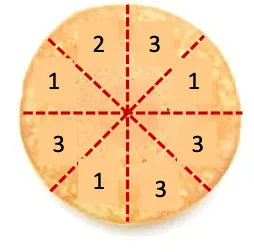
1) Classic potato = 3/8
2) Chilly panner = 1/8
3) Tangy tomato mix = 4/8
Let Us Explore
Q. Meena has 8 diyas. Colour 1/4 of her diyas red. To find 1/4, let us divide the number of diyas into 4 equal parts. Can you see how to divide the diyas into 4 equal parts? Now colour 2 diyas red.
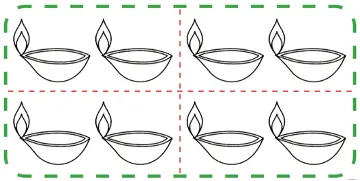
Solution:

Page 74
Let Us Do
Now let us try to find fractions for the situations given below. Circle the appropriate parts in the pictures.
1. There are 12 cookies. What fraction of cookies will each get if the number of children are as follows:
a) 3 children
b) 6 children
c) 2 children
d) 4 children
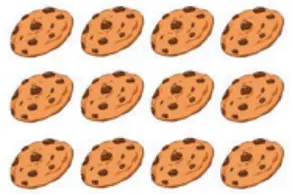
Solution:
a) Number of children = 3
Total cookies = 12
Cookies each child will get = 12/3 = 4.
Fraction of cookies each child will get = 4/12 = 1/3.
b) Number of children = 6
Total cookies = 12
Cookies each child will get = 12/6 = 2.
Fraction of cookies each child will get = 2/12 = 1/6.
c) Number of children = 2
Total cookies = 12
Cookies each child will get = 12/2 = 6.
Fraction of cookies each child will get = 6/12 = 1/2.
d) Number of children = 4
Total cookies = 12
Cookies each child will get = 12/4 = 3.
Fraction of cookies each child will get = 3/12 = 1/4.
2. Simran calls her school friends for her birthday party. 1/3 of her friends receive a hairband as their return gift. Place hairbands on 1/3 of her friends.
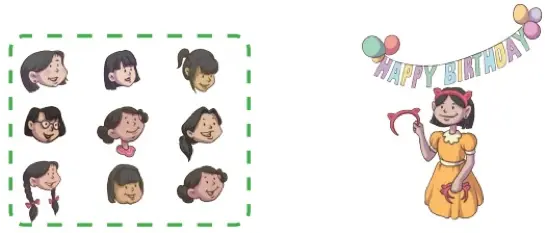
Solution:
Do it yourself.
3. Draw flowers in 1/5 of the given number of pots.

Solution:
Do it yourself.
Page 75
Let Us Find Fractions in Our Surroundings
1. Yesterday Mummy asked to divide a box of barfis into four equal parts. There are 16 barfis in the box. Draw a picture of 16 barfis and find 1/4 of the whole. How many barfis are in each part?
Solution:
Number of barfis in the box = 16
Number of barfis in each part = 16 × 1/4 = 4.
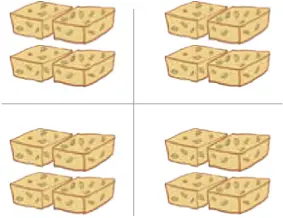
2. Rohan has a piece of ribbon to decorate his notebook. Mohan’s ribbon is one-fourth as long as Rohan’s ribbon. How long will Rohan’s ribbon be? Draw it.
Mohan’s Ribbon

Solution:
Length of Mohan’s ribbon = 1/4 × length of Rohan’s ribbon.
Therefore, length of Rohan’s ribbon = 4 × length of Mohan’s ribbon.
Rohan’s ribbon:

Try Yourself
Q. Observe your surroundings and think of situations where we use fractions and write any two of them.
Solution:
(i) Cooking and baking: We use fractions when measuring ingredients for a recipe. For example, 2/3 cup of flour or 1/2 teaspoon of sugar.
(ii) Time measurement: We often use fractions when measuring time intervals. For example –
1/2 of an hour or 21/2 hour.
Page 76
Let Us Do
1. Take a rectangular piece of paper and fold the paper into three equal parts and then unfold it.
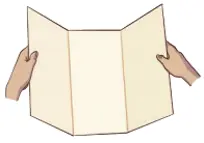
2. Colour one of the three equal parts as shown in the image.
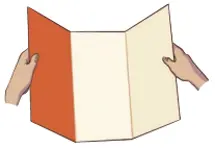
3. Fold the paper back into three equal parts like before, and then fold it in half.
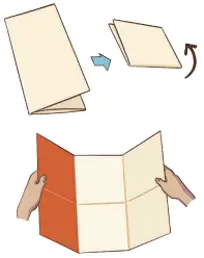
4. Observe the colored part. What is the fraction for the shaded part now? What does this mean?
5. Fold the paper again and check how the coloured part changes.
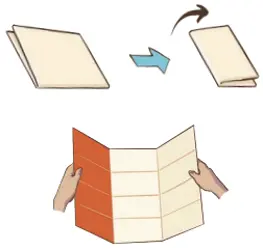
6. Write down what fraction you observe after each fold.
1/3 = 2/6 = ______ = ______ = ______
Solution:
1/3 = 2/6 = 3/9 = 4/12 = 5/15
Page 77
Q. Take another piece of paper and try the same starting with two equal parts, and halving every time. Share the findings with your friends.
1/2 = 2/4 = ______ = ______ = ______
Solution:
1/2 = 2/4 = 3/6 = 4/8 = 5/10
These fractions are all equal because the ratio between the numerator and denominator is always the same, exactly half.
Let Us Discuss
Q. Observe the fraction chart and discuss the following questions. You may use your fraction kit also to explore the answers.
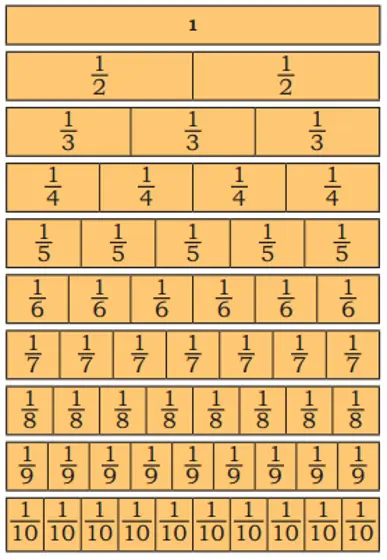
1. How many 1/4 s are equal to 1/2 ?
Solution:
Two.
2. Is 2/3 less than or greater than 1/2 ?
Solution:
1/3 + 1/3 is greater than 1/2.
Therefore, 2/3 is greater than 1/2.
3. Ten pieces of 1/10 make a complete whole. Is this statement true?
Solution:
Yes, this statement is true because 1/10 × 10 = 1.
4. Three pieces of 1/6 are equal to two pieces of 1/8. Is this true?
Solution:
No, this is not true because 3 pieces of 1/6 are equal to four pieces of 1/8.
5. How many pieces of 1/8 make 1/4?
Solution:
2 pieces.
Page 78
Let Us Do
1. Bablu is playing with square shapes. He wants to cut them in such a way that each piece is equal in size. Circle the squares which have been cut into equal parts. Write the fraction for the shaded part, whenever possible.

Solution:
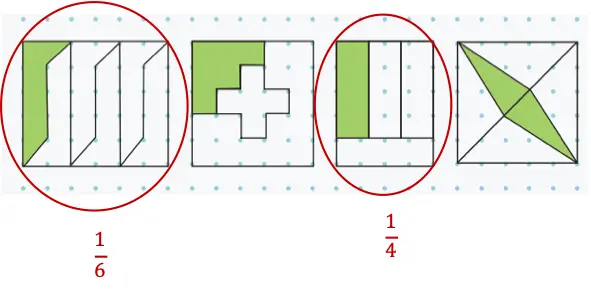
2. Check if the children’s claim below about the shaded parts of each of the pictures is correct. Circle the ones which you think are correct, cross out the ones which are not correct. You can draw additional lines to make the parts equal. Discuss your thinking.
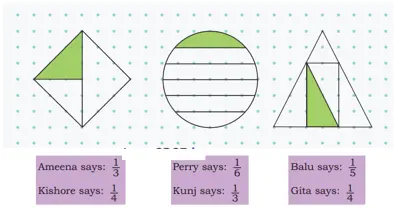
Solution:
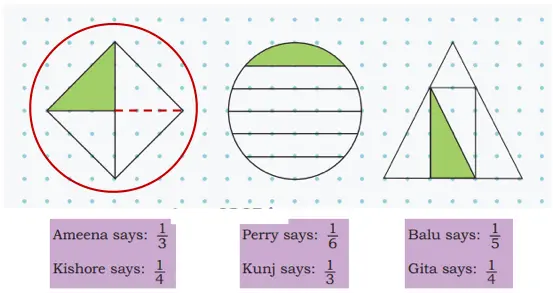
1st figure: Ameena is wrong, but Kishore is right.
2nd figure: Both Perry and Kunj are wrong.
3rd figure: Both Balu and Gita are wrong.
Page 79
3. Identify the fractions represented by the coloured parts in the given pictures.

Solution:
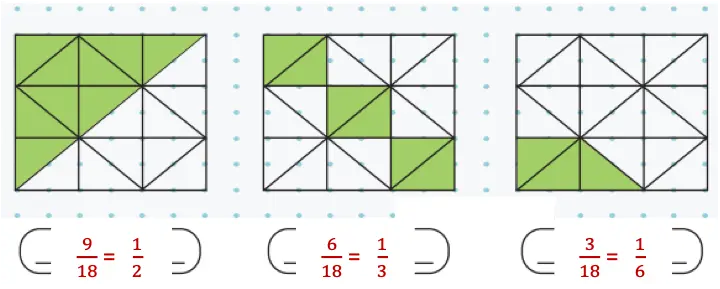
4. Identify the fraction of the whole that the blue parts make in each of the pictures given below.
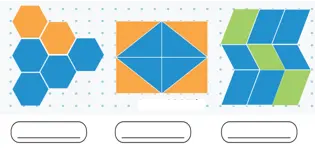
Solution:
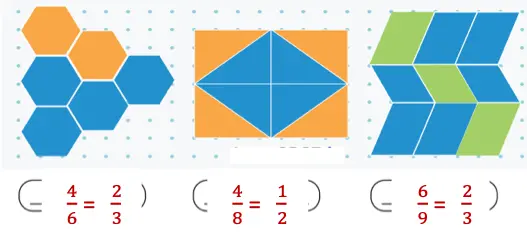
5. Divide the following into equal parts and shade the appropriate parts in each.
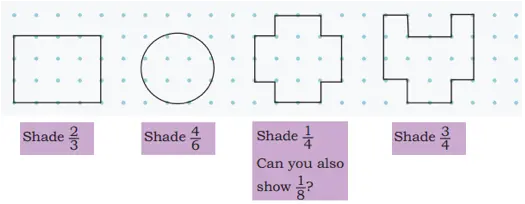
Solution:

